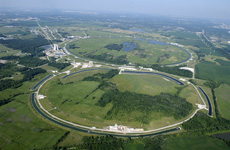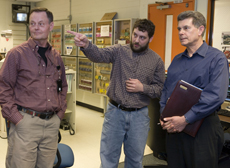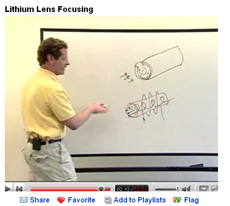|
Tuesday, Mar. 18
3:30 p.m.
DIRECTOR'S COFFEE BREAK - 2nd Flr X-Over
THERE WILL BE NO ACCELERATOR PHYSICS AND TECHNOLOGY SEMINAR TODAY
Wednesday, March 19
2-3:30 p.m.
Central Unix Web Service Town Meeting - One West
3:30 p.m.
DIRECTOR'S COFFEE BREAK - 2nd Flr X-Over
4 p.m.
Fermilab Colloquium - One West
Speaker: J. Mastrianni, University of Chicago
Title: Prions: Misfolded Proteins and Fatal Transmissible Neurodegenerative Diseases
Click here for NALCAL,
a weekly calendar with links to additional information. |
Tuesday, March 18
- Chicken & rice soup
- Low carb burger
- Baked meatloaf w/gravy
- Smart Cuisine: salmon provencal
- Peppered beef
- Assorted pizza slices
- Chipotle chili & queso nachos supreme
Wilson Hall Cafe Menu |
|
Wednesday, March 19
Lunch
- Trout almondine
- Lemon scented rice
- Vegetable of the season
- Amaretto cheesecake
Thursday, March 20
Dinner
- Seviche
- Paella
- Watercress, oranges & red onion salad
- Brazo de gitano
Chez Leon Menu
Call x4598 to make your reservation. |
|
|
Tevatron sets new
luminosity records

The Tevatron set records for peak and integrated luminosity.
On Monday morning at 6:01 a.m., the Tevatron entered a new era of performance. The collider produced more particle collisions per second than ever before. It achieved a record peak luminosity of 3.15 E32 cm-2sec-1, breaking the barrier of 3E32 for the first time. A few days earlier, the Tevatron produced a peak luminosity of 2.85E32, the second-best store.
The record came on the heels of a week that had seven stores with peak luminosities between 2.36 and 2.85E32. Combined, last week's stores yielded the largest number of proton-antiproton collisions ever produced in a single week. The total integrated luminosity for the week reached 46.5 inverse picobarns.
"This was just a great week," said AD's Dan Johnson as he presented the numbers at the All Experimenter's meeting on Monday afternoon. "It was a week you'd like to see: stacking and stashing. All accelerators performed well and it all came together. Lots of people contributed to this success, making plans, tuning the machines, performing studies and maintenance, making repairs and keeping all the systems operational."
For the past couple of months, the Antiproton Source set stacking records, producing record numbers of antiprotons and transferring stashes of them to the Recycler storage ring. But the rest of the accelerator complex did not yet perform at its best. Last week, everything came together. With no major equipment failures, plenty of antiprotons and quick turnaround times between Tevatron stores, the accelerator complex racked up more collisions than ever before.
Steve Holmes, associate director for accelerators, and Joanna Livengood, manager of the DOE Fermi Site Office, congratulated the Accelerator Division and everybody who contributed to this success.
--Kurt Riesselmann
|
Congressional fellow learns about Fermilab site, programs

Steve Traver (right), congressional fellow for Steve Pearch (R-NM), learns about the Main Control Room from AD Operations employee Brian Schupbach and department head Roger Dixon. During his visit to the laboratory Friday, March 14, Traver met with Director Pier Oddone, AD department members, US CMS's Erik Gottschalk, CMS Communicator Elizabeth Clements and Neutron Therapy's Thomas Knox. He toured the Linac, Remote Operations Center, 15th floor and the Neutron Therapy Facility.
|
Science group boils down need for breakthroughs
From Chicago Tribune,
March 17, 2008
For people raised on the Web and instant gratification, where gadgets go from must-have to old stuff in half a year, Robert Rosner has some news: The interval from a science breakthrough to commercial viability is measured in decades, not months.
Computers were around for 30 years before they became useful to business, and solid-state electronics consumer products didn't catch on until a generation after the transistor was discovered, said Rosner, director of Argonne National Laboratory.
"When a basic discovery is made, no one has any idea what it will lead to," said Rosner. And this disconnect is behind the financial crisis now afflicting Argonne and its sister institution, Fermilab.
Read more
|
|
|
|
Director Pier Oddone is on furlough. The column will resume next week.
|
Solenoid vs. toroid:
magnet explanation

AD's Dave McGinnis explains the difference between solenoidal and toroidal magnets and fields.
In last week's Director's Corner, the magnet field of the lithium lens used in the Antiproton Source was described as solenoidal. The lithium lens actually uses a toroidal magnet, which produces a field that focuses wayward beamline particles back to the beamline. To get a better understanding of the two magnets and the fields they create, we asked AD's Dave McGinnis about the difference. Watch McGinnis' explanation in a 2 1/2 minute YouTube video.
|
Durbin urges emergency fund grants for Fermilab
From Beacon News,
March 18, 2008
U.S. Sen. Dick Durbin joined a group of his colleagues from both parties in asking the Senate Appropriations Committee for more money for scientific research.
In a letter to the committee's chairman, Robert C. Byrd, Durbin and his colleagues requested an additional $250 million for the Department of Energy's Office of Science, and $100 million for the National Science Foundation.
And they would like to see that money appropriated this year, in a supplemental appropriations bill.
The $250 million would restore projects cut at Fermi National Accelerator Laboratory, the DOE's particle physics lab in Batavia. Last year, Congress passed an appropriations bill that cut Fermilab's funding by $52 million, forcing the facility to halt projects in progress and put employees on rolling furloughs. Layoffs will likely follow later this year, with 10 percent of the lab's staff expected to lose their jobs.
Read more
|
|
Have a safe day!
Unix Web service meeting
The CD Central Services Group will hold a central Unix Web service town meeting on Wednesday, March 19, to get input on Web needs and long-term Web service direction.
Discounted tickets available
Discounted tickets are available for the following events: Chicago Bulls at the United Center, March 22, $26 and March 25, $30.
Going to CERN?
Take your camera! Have your photos featured in the Fermilab Remote
Operations Center online gallery. Contact Elizabeth Clements
for details.
Scottish Country Dance Tuesday
Scottish Country Dancing will meet Tuesday, March 18, at Kuhn Barn on the Fermilab site. Instruction begins at 7:30 p.m. and newcomers are always welcome. Most dances are fully taught and walked through, and you do not need to come with a partner. For more information, call (630) 840-8194 or (630) 584-0825 or folkdance@fnal.gov.
Additional Activities
|
|